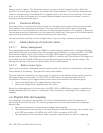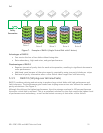
Dell
DELL PERC H700 and H800 Technical Guide 24
Figure 6. Example of RAID 5 (Single Virtual Disk with 5 drives)
Advantages of RAID 5
Most efficient use of drive capacity of all the redundant RAID configurations
High read transaction rate
Medium-to-high write transaction rate
Disadvantages of RAID 5
Disk failure has a medium impact on throughput
Most complex controller design
Retrieval of parity information after a drive failure takes longer than with mirroring
5.3.4 RAID 6 (Striping With Dual Distributed Parity)
RAID 6 provides data redundancy by using data striping in combination with parity information. See
Figure 7. Similar to RAID 5, the parity is distributed within each stripe. RAID 6, however, uses an
additional physical disk to maintain parity, such that each stripe in the disk group maintains two disk
blocks with parity information. The additional parity provides data protection in the event of two
disk failures.
Figure 7 depicts the RAID 6 data layout. The second set of parity drives are denoted by Q. The P
drives follow the RAID 5 parity scheme. The parity blocks on Q drives are computed using Galois Field
mathematics. There is no performance hit on read operations. However, as a second independent
parity data needs to be generated for each write operation, there is a performance hit during write.
Due to dual data protection, a RAID 6 VD can survive the loss of two drives or the loss of a drive when
one of its drives is being rebuilt.
Drive 1
Drive 2
Drive 3
Drive 4
Drive 5
Parity
Generation
1 parity
0 parity
4 parity
3 parity
2 parity
Data 1
Data 2
Data 3
Data 4
Data 5
Data 6
Data 7
Data 8
Data 9
Data 10
Data 11
Data 12
Data 13
Data 14
Data 16
Data 15
Data 18
Data 20
Data 17
Data 19


















